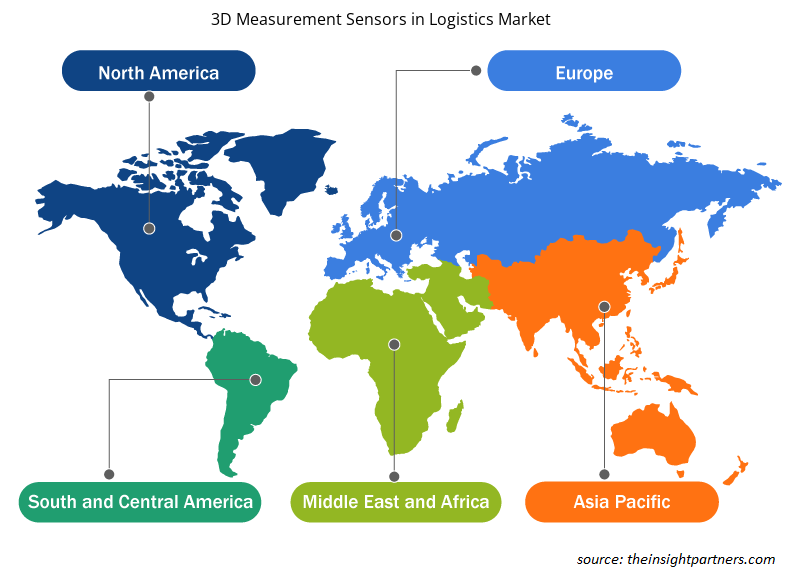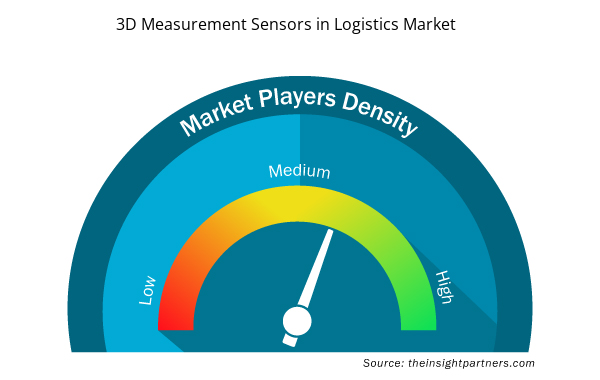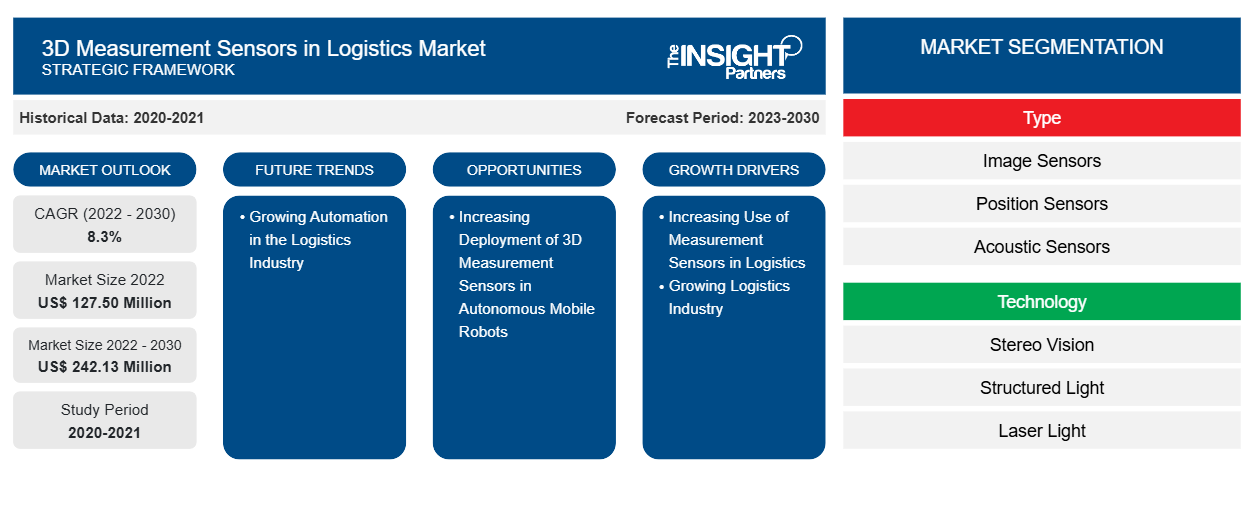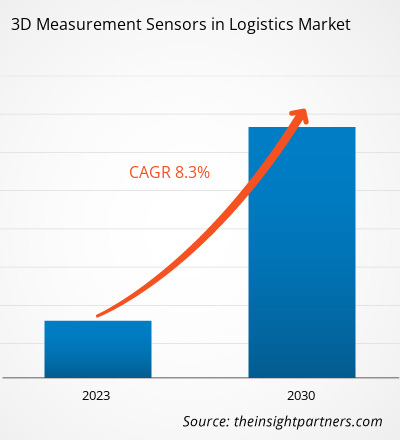[研究报告] 物流市场规模中的 3D 测量传感器预计将从 2022 年的 1.275 亿美元增长到 2030 年的 2.4213 亿美元;预计在预测期内复合年增长率为 8.3%。
分析师观点:
全球物流行业对 3D 图像传感器、3D 位置传感器和 3D 深度传感器的需求正在增加,因为这些传感器有助于跟踪仓库内的货物移动。此外,这些传感器还可以帮助公司识别瓶颈并根据需要优化仓库布局,从而推动物流市场中 3D 测量传感器的增长。此外,随着电子商务行业的不断发展,物流行业也在迅速增长。这种增长带来了对自动化的需求,通过机器视觉、资产跟踪、数据捕获扫描和物体尺寸测量提供实时数据,进一步提高运营效率。此外,3D 测量传感器在机器人技术中的使用正在增加,因为传感器可以帮助机器人更好地了解周围环境,从而帮助它们在仓库中有效地执行拾取和抓取操作,为物流市场中 3D 测量传感器的增长创造了机会。
市场概况:
3D 测量传感器用于以电子方式获取信息,并使用这些数据来改善人、设备和世界之间的界面。这些传感器采用 3D 传感技术,该技术利用近红外光反射、摄影、几何原理和先进的计算能力,使机器能够获取有关人和物体的详细信息,并可进一步处理为有意义的信息。3D 传感器的需求正在大幅增长,因为它们被用于仓库和物流运营以提高效率。在仓库中,传感器用于订单履行,因为它们有助于更有效地监控产品损坏和其他不合格情况,从而推动了物流市场中 3D 测量传感器的增长。
定制此报告以满足您的需求
您可以免费定制任何报告,包括本报告的部分内容、国家级分析、Excel 数据包,以及为初创企业和大学提供优惠和折扣
- 获取此报告的关键市场趋势。这个免费样品将包括数据分析,从市场趋势到估计和预测。
市场驱动因素:
测量传感器在物流中的应用日益广泛 物流市场中的 3D 测量传感器
图像传感器、位置传感器和声学传感器等测量传感器的使用日益增多,简化了许多物流操作。图像传感器用于物流配送系统中的目标识别,以有效管理配送过程。位置传感器用于检测任何材料类型和表面特性的物体的位置。位置传感器将有关物体运动的数据转换为信号,进一步帮助提供位置反馈。借助测量传感器,可以轻松执行各种物流和仓库管理操作,例如监控库存水平、减少库存错误和优化存储空间。除了跟踪仓库内的货物移动外,这些传感器还可以帮助公司识别瓶颈并优化仓库布局。此外,测量传感器可用于收集紧急事件现场的数据,以促进对物流操作的分析。这些数据可以进一步帮助改善新操作的规划和准备。实时信息可以提供更好的态势感知,也可以用作基于人工智能或优化算法的自动决策支持的输入。因此,越来越多地使用测量传感器来提高配送中心和仓库的效率,正在推动 3D 测量传感器在物流市场的增长。
节段分析:
根据技术,物流市场中的 3D 测量传感器分为:
- 立体视觉
- 结构光
- 激光灯
- 其他的
2022 年,结构光部分占据了物流市场中 3D 测量传感器的最大份额。结构光技术增强了物流中的 3D 测量能力,可实现精确的体积分析、尺寸检查、分类优化、负载规划和质量控制。它还可以对物流中的物体进行精确的尺寸检查。因此,预测期内对结构光的需求不断增长将进一步推动物流市场中 3D 测量传感器的增长。
区域分析:
物流中的 3D 测量传感器市场规模大致分为五个主要区域:北美、欧洲、亚太地区 (APAC)、中东和非洲 (MEA) 和南美 (SAM)。2022 年,北美在物流中的 3D 测量传感器市场份额最大,其次是欧洲和亚太地区。预计 2022 年至 2030 年,亚太地区将在物流市场中的 3D 测量传感器中实现最高的复合年增长率。
在北美,技术创新预计将为物流市场中 3D 测量传感器的增长提供机会。该地区的各家物流公司都在对其仓库进行自动化以提高生产力。这增加了对各种仓库自动化解决方案的需求,包括3D 摄像机和机器人,推动了北美物流市场中 3D 测量传感器的增长。此外,该地区的电子商务行业正在经历巨大的增长,这增加了物流行业对自动化的采用,从而推动了物流市场中 3D 测量传感器的增长。
关键球员分析:
Micro-Epsilon Messtechnik GmbH & Co KG、英飞凌科技股份公司、索尼半导体解决方案公司、康耐视公司、ifm Electronic GmbH、英特尔公司、LMI Technologies Inc、Keyence 公司、欧姆龙公司和 Sick AG 是报告中物流市场 3D 测量传感器的主要参与者。在这些参与者中,Micro-Epsilon Messtechnik GmbH & Co KG 和英飞凌科技股份公司是物流市场 3D 测量传感器的两大参与者,因为它们提供的产品组合多样化。
物流市场中的 3D 测量传感器区域洞察
Insight Partners 的分析师已详细解释了预测期内影响物流市场 3D 测量传感器的区域趋势和因素。本节还讨论了物流市场 3D 测量传感器的细分市场和地理位置,包括北美、欧洲、亚太地区、中东和非洲以及南美和中美洲。

- 获取物流市场 3D 测量传感器的区域特定数据
物流市场中的 3D 测量传感器报告范围
| 报告属性 | 细节 |
|---|---|
| 2022 年市场规模 | 1.275亿美元 |
| 2030 年市场规模 | 2.4213亿美元 |
| 全球复合年增长率(2022 - 2030 年) | 8.3% |
| 史料 | 2020-2021 |
| 预测期 | 2023-2030 |
| 涵盖的领域 | 按类型
|
| 覆盖地区和国家 | 北美
|
| 市场领导者和主要公司简介 |
|
物流市场参与者密度中的 3D 测量传感器:了解其对业务动态的影响
物流市场中的 3D 测量传感器市场正在快速增长,这得益于终端用户需求的不断增长,这些需求源于消费者偏好的不断变化、技术进步以及对产品优势的认识不断提高等因素。随着需求的增加,企业正在扩大其产品范围,进行创新以满足消费者的需求,并利用新兴趋势,从而进一步推动市场增长。
市场参与者密度是指在特定市场或行业内运营的企业或公司的分布情况。它表明在给定市场空间中,相对于其规模或总市场价值,有多少竞争对手(市场参与者)存在。
在物流市场中运营 3D 测量传感器的主要公司有:
- Micro-Epsilon Messtechnik GmbH & Co KG
- 英飞凌科技股份公司
- 索尼半导体解决方案公司
- 康耐视公司
- ifm 电子有限公司
免责声明:上面列出的公司没有按照任何特定顺序排列。

- 获取物流市场 3D 测量传感器主要参与者概览
最新动态:
物流市场中的 3D 测量传感器公司高度采用并购等无机和有机策略。以下列出了一些近期的关键市场发展:
- 2021 年,Micro-Epsilon 开发了一款 3D 快照传感器表面 CONTROL 3D 3200,它是在无光泽表面上进行精确几何形状和表面测量的正确选择。该传感器专为自动化在线质量检查而开发。
- 2020年,英飞凌科技股份公司完成对赛普拉斯半导体公司的收购。此次收购旨在为客户提供业界最全面的产品组合,以连接现实世界与数字世界并塑造数字化。
- 2020年,欧姆龙株式会社宣布,将于9月1日起在日本发售B5L系列嵌入式3D TOF传感器模块,并于10月1日起在全球发售。B5L系列采用独特的光学设计技术,即使在阳光下也能稳定大面积的三维距离信息。
- 2019 年,SICK 集团通过转让合资公司所有者 Schädler 家族所持有的 50% 股份,完成了对智利合资公司 SICK SpA 的收购。通过此次收购,SICK 成为 SICK SpA 的唯一所有者,从而巩固了其在南美市场的地位。
- 2019 年,SICK AG 在中国开设了新的生产基地,专注于本地化产品生产以及针对个人客户的系统建设。通过此次扩张,公司将能够为客户提供更强大的自动化解决方案。
- 历史分析(2 年)、基准年、预测(7 年)及复合年增长率
- PEST 和 SWOT 分析
- 市场规模价值/数量 - 全球、区域、国家
- 行业和竞争格局
- Excel 数据集


- Parking Management Market
- Influenza Vaccines Market
- Occupational Health Market
- Equipment Rental Software Market
- Asset Integrity Management Market
- Molecular Diagnostics Market
- Nitrogenous Fertilizer Market
- Integrated Platform Management System Market
- Hair Extensions Market
- Vertical Farming Crops Market

Report Coverage
Revenue forecast, Company Analysis, Industry landscape, Growth factors, and Trends

Segment Covered
This text is related
to segments covered.

Regional Scope
North America, Europe, Asia Pacific, Middle East & Africa, South & Central America

Country Scope
This text is related
to country scope.
常见问题
1. Increasing Use of Measurement Sensors in Logistics
2. Growth of Logistics Industry
3D measurement sensors in logistics market accounted for US$ 127.50 Million in the year 2022 and is expected to grow at a CAGR of 8.3% during the forecast period, to account for US$ 242.13 Million in the year 2030.
Growing Automation in Logistics Industry
Asia Pacific is anticipated to grow with the highest CAGR over the forecast period.
The 3D measurement sensors in logistics market are expected to reach US$ 242.13 Million in the year 2030.
The key players holding majority shares in the 3D measurement sensors in logistics market include Micro-Epsilon Messtechnik GmbH & Co KG, Infineon Technologies AG, Sony Semiconductor Solutions Corp, Cognex Corp., and ifm Electronic GmbH.
Trends and growth analysis reports related to Electronics and Semiconductor : READ MORE..
The List of Companies - 3D Measurement Sensors in Logistics Market
- Micro-Epsilon Messtechnik GmbH & Co KG
- Infineon Technologies AG
- Sony Semiconductor Solutions Corp
- Cognex Corp
- ifm Electronic GmbH
- Intel Corp
- LMI Technologies Inc
- Keyence Corp
- OMRON Corp
- Sick AG
The Insight Partners performs research in 4 major stages: Data Collection & Secondary Research, Primary Research, Data Analysis and Data Triangulation & Final Review.
- Data Collection and Secondary Research:
As a market research and consulting firm operating from a decade, we have published and advised several client across the globe. First step for any study will start with an assessment of currently available data and insights from existing reports. Further, historical and current market information is collected from Investor Presentations, Annual Reports, SEC Filings, etc., and other information related to company’s performance and market positioning are gathered from Paid Databases (Factiva, Hoovers, and Reuters) and various other publications available in public domain.
Several associations trade associates, technical forums, institutes, societies and organization are accessed to gain technical as well as market related insights through their publications such as research papers, blogs and press releases related to the studies are referred to get cues about the market. Further, white papers, journals, magazines, and other news articles published in last 3 years are scrutinized and analyzed to understand the current market trends.
- Primary Research:
The primarily interview analysis comprise of data obtained from industry participants interview and answers to survey questions gathered by in-house primary team.
For primary research, interviews are conducted with industry experts/CEOs/Marketing Managers/VPs/Subject Matter Experts from both demand and supply side to get a 360-degree view of the market. The primary team conducts several interviews based on the complexity of the markets to understand the various market trends and dynamics which makes research more credible and precise.
A typical research interview fulfils the following functions:
- Provides first-hand information on the market size, market trends, growth trends, competitive landscape, and outlook
- Validates and strengthens in-house secondary research findings
- Develops the analysis team’s expertise and market understanding
Primary research involves email interactions and telephone interviews for each market, category, segment, and sub-segment across geographies. The participants who typically take part in such a process include, but are not limited to:
- Industry participants: VPs, business development managers, market intelligence managers and national sales managers
- Outside experts: Valuation experts, research analysts and key opinion leaders specializing in the electronics and semiconductor industry.
Below is the breakup of our primary respondents by company, designation, and region:

Once we receive the confirmation from primary research sources or primary respondents, we finalize the base year market estimation and forecast the data as per the macroeconomic and microeconomic factors assessed during data collection.
- Data Analysis:
Once data is validated through both secondary as well as primary respondents, we finalize the market estimations by hypothesis formulation and factor analysis at regional and country level.
- Macro-Economic Factor Analysis:
We analyse macroeconomic indicators such the gross domestic product (GDP), increase in the demand for goods and services across industries, technological advancement, regional economic growth, governmental policies, the influence of COVID-19, PEST analysis, and other aspects. This analysis aids in setting benchmarks for various nations/regions and approximating market splits. Additionally, the general trend of the aforementioned components aid in determining the market's development possibilities.
- Country Level Data:
Various factors that are especially aligned to the country are taken into account to determine the market size for a certain area and country, including the presence of vendors, such as headquarters and offices, the country's GDP, demand patterns, and industry growth. To comprehend the market dynamics for the nation, a number of growth variables, inhibitors, application areas, and current market trends are researched. The aforementioned elements aid in determining the country's overall market's growth potential.
- Company Profile:
The “Table of Contents” is formulated by listing and analyzing more than 25 - 30 companies operating in the market ecosystem across geographies. However, we profile only 10 companies as a standard practice in our syndicate reports. These 10 companies comprise leading, emerging, and regional players. Nonetheless, our analysis is not restricted to the 10 listed companies, we also analyze other companies present in the market to develop a holistic view and understand the prevailing trends. The “Company Profiles” section in the report covers key facts, business description, products & services, financial information, SWOT analysis, and key developments. The financial information presented is extracted from the annual reports and official documents of the publicly listed companies. Upon collecting the information for the sections of respective companies, we verify them via various primary sources and then compile the data in respective company profiles. The company level information helps us in deriving the base number as well as in forecasting the market size.
- Developing Base Number:
Aggregation of sales statistics (2020-2022) and macro-economic factor, and other secondary and primary research insights are utilized to arrive at base number and related market shares for 2022. The data gaps are identified in this step and relevant market data is analyzed, collected from paid primary interviews or databases. On finalizing the base year market size, forecasts are developed on the basis of macro-economic, industry and market growth factors and company level analysis.
- Data Triangulation and Final Review:
The market findings and base year market size calculations are validated from supply as well as demand side. Demand side validations are based on macro-economic factor analysis and benchmarks for respective regions and countries. In case of supply side validations, revenues of major companies are estimated (in case not available) based on industry benchmark, approximate number of employees, product portfolio, and primary interviews revenues are gathered. Further revenue from target product/service segment is assessed to avoid overshooting of market statistics. In case of heavy deviations between supply and demand side values, all thes steps are repeated to achieve synchronization.
We follow an iterative model, wherein we share our research findings with Subject Matter Experts (SME’s) and Key Opinion Leaders (KOLs) until consensus view of the market is not formulated – this model negates any drastic deviation in the opinions of experts. Only validated and universally acceptable research findings are quoted in our reports.
We have important check points that we use to validate our research findings – which we call – data triangulation, where we validate the information, we generate from secondary sources with primary interviews and then we re-validate with our internal data bases and Subject matter experts. This comprehensive model enables us to deliver high quality, reliable data in shortest possible time.


 获取此报告的免费样本
获取此报告的免费样本